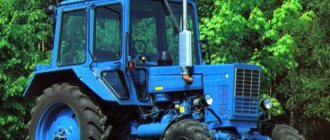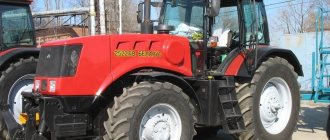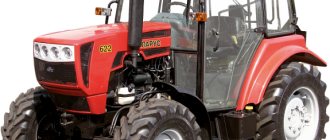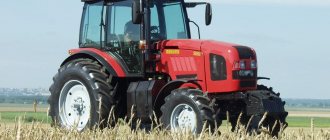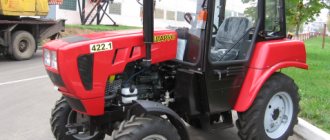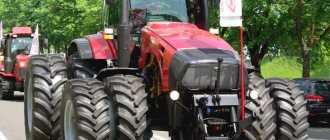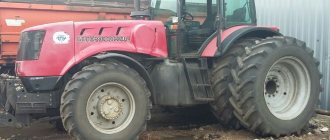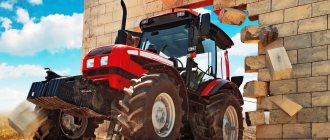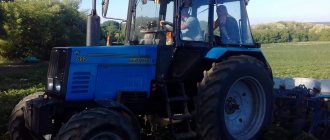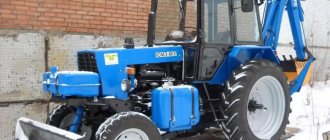The main idea of creating the MTZ 1220 tractor is to produce a traction class 2 machine using a four-cylinder D-245 diesel engine, where the development of power by the power plant up to 122 horsepower is achieved by improved parameters of fuel injection and air pressurization into the cylinders. Apart from the engine, the general concept of the machine is copied from a tractor of the same traction class MTZ 1221 with a six-cylinder diesel engine D-260.2 with a power of 130-136 hp. The MTZ 1220 modification range, with its main components of the transmission, chassis, hydraulics and control system, corresponds to the modifications of the MTZ 1221 tractor.
Modifications within the MTZ-1220 family
Several modifications of the MTZ-1220 tractor are produced - with different versions of the base D-245 engine. The engines of the first three modifications (MTZ-1220.1, MTZ-1220.2, MTZ-1220.3) comply with Stage 2 environmental standards. These versions of the Belarus 1220 tractors are the cheapest, aimed at the domestic market: Russia, Ukraine, etc.
The following modifications (from 4th to 7th) are equipped with more “advanced” engines in environmental terms and are aimed at export to European countries.
The Belarus MTZ-1220.4 tractor has a D-245.2S3A M (“Mercer”) engine. In terms of emissions of harmful substances, it meets the environmental requirements of stage IIIA (and not II, as in the base model).
The Belarus MTZ-1220.5 modification, launched on the market in 2012, is distinguished by another version of the four-cylinder diesel engine from MMZ - this is the D-245.2 S3B. It meets Stage 3B environmental requirements.
The Belarus MTZ-1220.6 version (released in 2022) is equipped with a D-245.2 S4 engine that meets Stage 4 environmental requirements.
The MTZ-1220.7 modification is equipped with a Caterpillar C3.6 diesel engine. It is almost similar in terms of power and torque to the D-245 diesel engine of the Minsk Motor Plant (power - 122.4 hp, maximum torque - 500 Nm), but complies with a more modern environmental standard - Stage 5.
Differences between tractor modifications
Today, the tractor is produced in four modifications: 1220.3, 1220.4, 1220.5, 1220.6, where the main differences between the models are the environmental standard of the engine, the level of automation of the diagnostic and control control system, and the ergonomic working conditions of the driver.
1220.3
The machine’s engine is equipped with a traditional engine fuel system with an in-line four-plunger fuel injection pump of the “Motrpal” brand PP4M10Pli-3704, produced in the Czech Republic, or a pump of a similar design, “YAZDA” brand 7731111005-07T, produced in the Russian Federation with a mechanical all-mode fuel supply regulator.
Tractor MTZ 1220.3
1220.4
The tractor is equipped with an imported “Mercer” or “Common RaiL” fuel system. The Mercer system has an exhaust gas recirculation control function using an integral module with a built-in solenoid valve and fuel pump speed sensor. In addition, the fuel injection pump regulator is equipped with a starting electromagnet, which limits the fuel supply with minimal air pressure at the time of starting the diesel engine.
1220.5
The MTZ 1220.5 modification is equipped with a “Common RaiL” fuel supply system, where fuel injection by injectors is electronically controlled with a system of solenoid valves. Increasing the environmental standard of the tractor is achieved by installing a catalytic neutralization system for exhaust gases. Engine operation is controlled by the electronic engine control system (ECM). When problems occur, operating parameters and error codes are displayed on a programmable monitor. This modification and the next version of the machine in the hydraulic linkage control system are equipped with external external buttons for convenient external control when connecting the equipment to the tractor. The PTO gearbox is also equipped with multi-disc hydraulic clutches instead of band brakes as on the MTZ 1220.3.
1220.6
The MTZ 1220.6 tractor is equipped with a Common RaiL fuel system and an improved exhaust gas neutralization system. Monitoring and diagnostics of all tractor and power plant systems is carried out by an integrated electronic control system (ECCS). The tractor control panel is equipped with a liquid crystal, programmable monitor indicating the operating parameters of all systems.
Tractor MTZ 1220.6
1220.7
This machine is presented by the Minsk Plant in exhibition, pre-production status. Unlike previous modifications, this version of the tractor is equipped with an imported Caterpillar diesel engine with a displacement of 3.6 liters and a power of 122 horsepower. The cabin has an updated design. The gearbox is fully synchronized.
Tractor engine MTZ-1220
The main power unit for the Belarus MTZ-1220 tractor is the D-245.2S2 engine from the Minsk Motor Plant. This is a four-stroke, four-cylinder diesel engine with direct fuel injection, turbocharging and intercooler.
Its power is 90 horsepower (122 kilowatts); rated speed – 2200 rpm. The working volume of the MMZ D-245 engine is 4.75 liters. Maximum torque – 501 N•m.
Cylinder diameter – 110 mm, piston stroke – 125 mm. The operating order of the cylinders is: 1-3-4-2.
The diesel power system includes a four-plunger in-line fuel pump, model PP4M10Pli-3704 (manufactured by Motorpal, Czech Republic) or 773.1111005 (JSC YaZDA, Russia). Regulator: mechanical centrifugal, all-mode, direct action, with automatic increase in diesel fuel supply after engine start.
The diesel lubrication system is of a combined type, with a liquid-oil heat exchanger and a booster pump. Oil purification: full-flow with a replaceable non-separable filter. Minimum oil pressure: 0.08 MPa at 600 rpm. Working pressure – 0.25…0.35 MPa.
Injectors: 455.1112010-50 or 172.1112010-11.01. Air purifier – with paper filter elements.
The specific consumption of diesel fuel at rated power is 234 g/kW•h. The torque reserve factor is 25 percent.
The fuel tank capacity of the Belarus MTZ-1220 tractor is 255 liters.
Transmission and axles of the Belarus 1220 tractor
The clutch on this tractor model is dry, double-disc, with metal-ceramic linings. The gearbox is mechanical, range, with constant mesh gears. Shifting four gears in each forward and reverse range is done using synchronizers. Number of gears – 16/8 (forward/backward).
Tractor travel speed: 1.7-36.7/3.1-17.2 (forward/backward).
The main gear of the rear axle is a pair of bevel gears with a circular tooth. Final drives – a pair of spur gears on each side. The final drives are planetary type. The differential locking mechanism is a hydraulic friction clutch.
The front drive axle is two-support, beam. It is equipped with planetary-cylindrical gearboxes. The rear axle is equipped with final planetary-cylindrical gears. The power take-off shaft drive is with a hydraulically controlled friction clutch.
The tractor is equipped with a rear PTO power take-off shaft - independent, with a frequency of 540 rpm, or 1000 rpm; synchronous - 4.18 rpm of path. The power take-off shaft control is electro-hydraulic.
Advantages of the tractor
The main advantage of the tractor is its traction class 2, which allows the tractor to be combined with more productive tillage equipment. The traction reserve also expands the running capabilities of the tractor when towing trailers and machines, and a more powerful PTO allows the tractor to be actively used with driven machines.
Owners are especially pleased with the tractor when working with rototillers and bed formers, where the speed of work and the quality of the operation performed is not inferior to the MTZ 1221, and fuel consumption is much lower. If we compare the tractor with the MTZ 82, in addition to the engine power, the advantage of the design is the powerful front drive axle with a reliable drive built into the gearbox. An additional advantage of the reinforced tractor transmission is its resistance to loads when working with a front loader or other loading equipment. The new design and modern layout of the cabin, together with electro-hydraulic control of transmission elements, significantly improves the ergonomics of tractor control.
Brakes and steering
The tractor uses three-disc dry brakes of a larger standard size, with a mechanical servo drive. Each brake is controlled by a separate pedal. The brake drive is mechanical. The diameter of the brake discs is 204 mm. An additional option is 8-disc brakes operating in an oil bath.
A reduced size (178 mm) double disc dry parking brake is attached to the right hand brake housing.
Steering – hydraulic volumetric (HPS). Power pump: NSh14, gear, left rotation. The position of the steering wheel can be adjusted in angle of inclination - from 25 to 40 degrees, with fixation in four positions, in height - steplessly along the axis of the steering shaft, 100 ± 20 mm. The free play of the steering wheel when the feed pump is running is no more than 25 degrees.
Hydraulic mounted system of the MTZ-1220 tractor
The mounted hydraulic system includes a separate-unit mounted mechanism with a hydraulic lift - two plunger-type cylinders.
Together with all kinds of agricultural implements, it works in four different modes: high-altitude; by force; positional and combined.
The hydraulic mounted system provides various adjustments to the positions of agricultural implements - power, position, mixed and height. Hydraulic system outlets: three pairs and one drain outlet (rear).
The rear linkage is an articulated four-link linkage of the second category. The load capacity of the rear linkage on the suspension axis is 4200 kilograms. The maximum pressure indicator is 20 MPa. The performance of the hydraulic pump reaches 56 liters per minute. The capacity of the hydraulic system is 28 liters.
The hydraulic lifting system is controlled by two handles, which are located in the cab on the right control panel.
Universal row-crop tractor (MTZ 1200)
Designed to perform a full range of agricultural work, from soil preparation for sowing to harvesting and transport operations. Can be used in forestry and municipal services, construction, industry. The tractor is adapted to work in various soil and climatic zones and on all kinds of soils, including soils with low bearing capacity.
Having a wide range of various accessories and units of additional equipment, as well as towing devices, the tractor is capable of being aggregated with a variety of agricultural machines and equipment, making full use of its functionality in a unit with wide-cut and combined machines of both class 2 and some machines of class 3 with re-adjustment of the coupling elements of the front and rear linkage mechanisms.
Diesel - six-cylinder, in-line, turbocharged, with low fuel and oil consumption, meets safety and environmental requirements for the emission of harmful toxic substances and heavy particles, is adapted to the use of both domestic and imported fuels and lubricants, and has a sufficient reserve of torque.
Models with index “B” are equipped with a reversible control station and are designed for long-term operation in reverse mode.
The transmission differs from those previously used on tractors by the presence of:
- reinforced clutch with two discs and a rigid body;
- rear axle with planetary wheel reduction gears; differential with an electrohydraulic control system in the following modes: on, off and automatic depending on the angle of rotation of the wheels;
- two-speed rear power take-off shaft with independent and synchronous drive;
- dry three-disc or “wet” (on request) brakes with a drive to the service brakes of a parking and spare hand brake;
- diameter-reinforced final drive axle shafts and rear axle housing for mounting the rear linkage mechanism, axle sleeves, and towbar elements;
The front drive axle is of a portal or beam coaxial type, with wheel planetary gearboxes, double-support pivot units and hydraulic cylinders in the steering mechanisms, a durable bridge beam for hanging loading equipment and various front-mounted machines from the front. The front drive axle in combination with wide-profile front drive wheels (14.9 R24 or 420/70 R24 tires) increases the axle's lifting capacity and expands the range of use of tractors on the farm.
The cabin is injury-proof with a rigid frame made of bent shaped profiles, with glued-in tinted spherical windows. The cabin interior is made using molded upholstery and panels, carpets. The roof of the cabin is used as an emergency hatch and houses a ventilation and heating system, a control panel for some electrical lighting and alarm devices, a sun visor, a rearview mirror, and radio receivers. Sound-absorbing mastics and upholstery provide the sound, heat and moisture insulation required by regulations.
The hydraulic mounted system controls the operation of the tractor with mounted, semi-mounted and trailed agricultural implements and machines. The tractor can be equipped with two types of separate-unit hydraulic system: with an autonomous horizontal power cylinder or with two vertical power cylinders built into the hydraulic lift. The system provides high-altitude power, positional and mixed methods for regulating the depth of the organ's operation. The capacity of the oil tank is sufficient for working with hydraulically powered machines that require a large amount of oil to drive the working parts. Adapted for the use of both domestic and imported oils.
Rear PTO: independent, two-speed with hydromechanical control system. Two-speed independent has 540 and 1000 rpm, synchronous - 4.36 rpm of travel. It can be equipped with replaceable shanks of type 1, 1C, 2 and 3 with the number of splines 6, 8, 20 and 21. Differential locking: friction, automatic with hydraulic drive; has 3 operating modes: off; automatic switching on and off; forced on. Rear axle with closed bevel differential and planetary final drive.
PTO control is electrohydraulic, using a key from the control panel. The tractor control station is mounted to the right of the operator, taking into account the use of handles in reverse mode. Provides control of levers: manual fuel supply, sections of the hydraulic system distributor, rear PTO and keys for the rear linkage, automatic locking, FDA activation, etc. In addition to the main control post on the tractor, there are control posts on the instrument panel of the top panel of the cab roof.
Technical means that ensure the aggregation of the tractor with agricultural machinery: a rear three-point linkage device ensures coupling and installation of the working position of the implement in different positions in height relative to the tractor, lateral adjustment due to braces, rigid fixation and free position of the implement due to stretchers of longitudinal rods and a groove in the brace , allowing you to work with wide-cut machines to copy the field topography. The set of towing devices includes: automatic coupling devices SA-1, cross member TSU-1ZH-01, front linkage, towing device (drawbar), towing device TSU-2R (Python), towing device lift type TSU-ZV, on which it is possible to install towing devices from other manufacturers. The tractor has 3 pairs of free outlets for servicing hydraulic equipment using the attached high-pressure hoses. There is also the technical possibility of hydraulic selection of working fluid for the operation of hydraulic motors attached to the tractor of agricultural machinery and equipment.
Belarus 1200 in combination with various machines performs various types of work:
- Plant growing.
- basic tillage;
- surface tillage;
- fertilization;
- chemicalization of plants and protection;
- cultivation and harvesting of grain;
- cultivation and harvesting of potatoes;
- cultivation and harvesting of corn;
- cultivation and harvesting of vegetables;
- harvesting beets, flax, rapeseed and other industrial crops;
- feed preparation;
- transport and loading operations;
- Animal husbandry.
- removal and application of liquid and solid organic fertilizers to the soil;
- preparation of feed for silage and haylage;
- delivery of prepared feed to farms in winter, spring and autumn through difficult-to-pass areas for conventional delivery vehicles;
- preparation and grinding of feed;
- Land reclamation and irrigated agriculture.
- drainage of waterlogged lands;
- planning of drained lands and their processing;
- water supply by PTO-driven pumps to irrigation systems;
- Utilities.
- Road construction.
- Forestry.
- Industrial products.
- Transport.
Main and parking brakes are mechanical, dry, disc. The brake drive is hydrostatic separate. The trailer brake drive is pneumatic, interlocked with the tractor brake control (two-wire upon request).
Electrical equipment: generator set with a power of 1000 W with a rectified voltage of 14V. Starting system with a 24V starter with a power of 6kW, starting device with an aerosol flammable liquid.
Equipment: front and rear working lights; 4 pairs of hydraulic system terminals and a free-flow drain terminal. On request: creeper; ballast weights; pendulum tow hitch; reverse control station; spacer for doubling the rear wheels; pneumatic system single or double wire in accordance with ISO and CEE/ECC standards; height-adjustable towing device; front axle of beam type (track 1600-1900 mm), radio equipment (radio tape recorder), front linkage, front PTO.
Other technical characteristics in numbers
- Overall dimensions: total length (with loads and attachment system in transport position) – 4600 mm; width (at the ends of the rear wheel axle shafts) – 2250 mm; cabin height – 2890 mm.
- Tractor base – 2600 mm.
- Track width: on the front wheels - 1535-2120 mm, on the rear wheels - 1540...2440 mm.
- Agrotechnical clearance (under the sleeves of the rear wheels) – 630 mm.
- Ground clearance (on standard tires) – 450 mm.
- The operating weight of the tractor is 5610 kilograms.
- The maximum operating weight of the tractor is 8800 kg.
- The minimum turning radius of the tractor is 5 meters.
- The ford depth is 850 mm.
- Nominal traction force – 20 kN.
- Tire size: on the front wheels – 360/70R24, on the rear wheels – 18.4R38.
Chassis performance
| Ground clearance on standard tires, mm | 450 |
| Agrotechnical clearance under the sleeves of the rear wheels, mm | 630 |
| Tractor base, mm | 2600 |
| Track size, mm Front wheels Rear wheels | 1535, 1635, 1700, 1800, 1850, 1950, 2022, 2120 From 1540 to 1916, from 1946 to 2156 |
| Smallest turning radius, m | 4,5 |
| Maximum ford depth, m | 0,85 |
| Standard tires Front Rear | 420/70R24 18.4R38 |
| Permissible load on bridges, kN Front Rear | 40 60 |
| Maximum weight of towed trailer, kg No brakes With independent brake With overrun brake The trailer brake system is interlocked with the tractor brakes | 2500 4000 12000 20000 |
| Weight distribution on axles, kg With ballast front/rear Without ballast front/rear | 2395/3135 1830/3260 |
Possibility of aggregation of MTZ-1220
- Four-furrow plows, including reversible ones.
- Combined units – tillage, chisel.
- Cultivators for continuous tillage.
- Trailed conventional and disc harrows.
- Universal pneumatic seeders and precision seeders.
- Installations for applying organic and mineral fertilizers.
- Disc mowers, trailed conditioners.
- Rotary rakes and tedders.
- Balers.
- Trailed forage harvester.
- Silage and haylage packer.
- Feed transportation platform.
- Trailers and semi-trailers, including those for transporting hay rolls, and tippers.
In addition to agriculture, the Belarus MTZ-1220 model tractor can be effectively used in other industries. In particular, in construction; in logging; in land reclamation; in the work of public utilities.
The tractor can perform a variety of engineering tasks in conjunction with attachments. For example, after installing a blade, an earth drill and other narrowly focused tools on it.
Price and analogues
The cost of a new MTZ-1220 is from 1.5 to 2 million rubles. The price depends on the configuration of the device and the dealer.
A used tractor is sold on the secondary market - from 900 thousand to 1.1 million rubles, depending on condition.
Among the analogues, you can specify models that are similar in power:
- MTZ-1025 (110 hp);
- MTZ-1021.3 (110.2 hp).
From foreign manufacturers - Valtra T141H or JCB Fastrac 2115.
Cabin of the MTZ-1220 tractor
The cabin in tractors of this family is made in full compliance with European and generally accepted international standards.
In particular, there is a rigid frame that is guaranteed to protect the operator from serious injuries in the event of the tractor tipping over. The seat is equipped with a set of adjustments that allow you to choose a comfortable position that matches the physiological characteristics of the operator. Namely: the seat is adjusted according to the weight of the operator; there is a longitudinal adjustment “back and forth”; height adjustment; adjusting the seat backrest angle.
The cabin has decent protection from noise and vibration loads on the workplace, with a pre-installed heater and ventilation system.
Advantages and disadvantages
The following advantages of the device are highlighted.
- High-torque but economical engine.
- Reinforced design of the front and rear axles.
- All-wheel drive with differential locking.
- Improved vibration and noise insulation of the cabin.
- Maintainability. The machine operator can perform many operations even in the field.
Along with the advantages, operators also point out the disadvantages of the tractor.
- Insufficient basic equipment of the device leads to a reduction in the capabilities of the machine and forces you to purchase the equipment necessary for installation separately.
- Low engine life of the Minsk diesel engine.
What is included in the list of additional options
As additional equipment, potential buyers of MTZ-1220 tractors are offered a mechanical synchronized gearbox with a large number of gears - 24 forward / 12 reverse. The tractor can be equipped with an electronic hydraulic system; air conditioning; brakes operating in an oil bath; creeper; kit for doubling rear wheels; compressor with valve (without pneumatic system); 2-wire pneumatic trailer brakes; additional “trainee” seat in the cockpit. Instead of the standard main seat, you can install a more comfortable imported one.
The rear wheel doubling kit is very useful when working on sticky soils. Since increasing the contact area of the tires with the ground increases cross-country ability, controllability, and traction capacity.
The creeper allows you to reduce operating speeds in lower gears and thereby increase the traction of the MTZ-1220 tractor.
Flaws
Considering the harsh temperature conditions in the operation of a forced diesel engine, the tractor is sensitive to a decrease in radiator heat transfer. Practitioners recommend blowing out the radiator grille more often for normal engine cooling operation. The main cases of diesel overheating are associated with dusty operating conditions at maximum speed when performing technological operations in the field.
Minor breakdowns inherent in any model of MTZ tractor associated with untimely maintenance of the machine and the quality of components (oil seals and cuffs, connecting pipelines) are also no exception.

